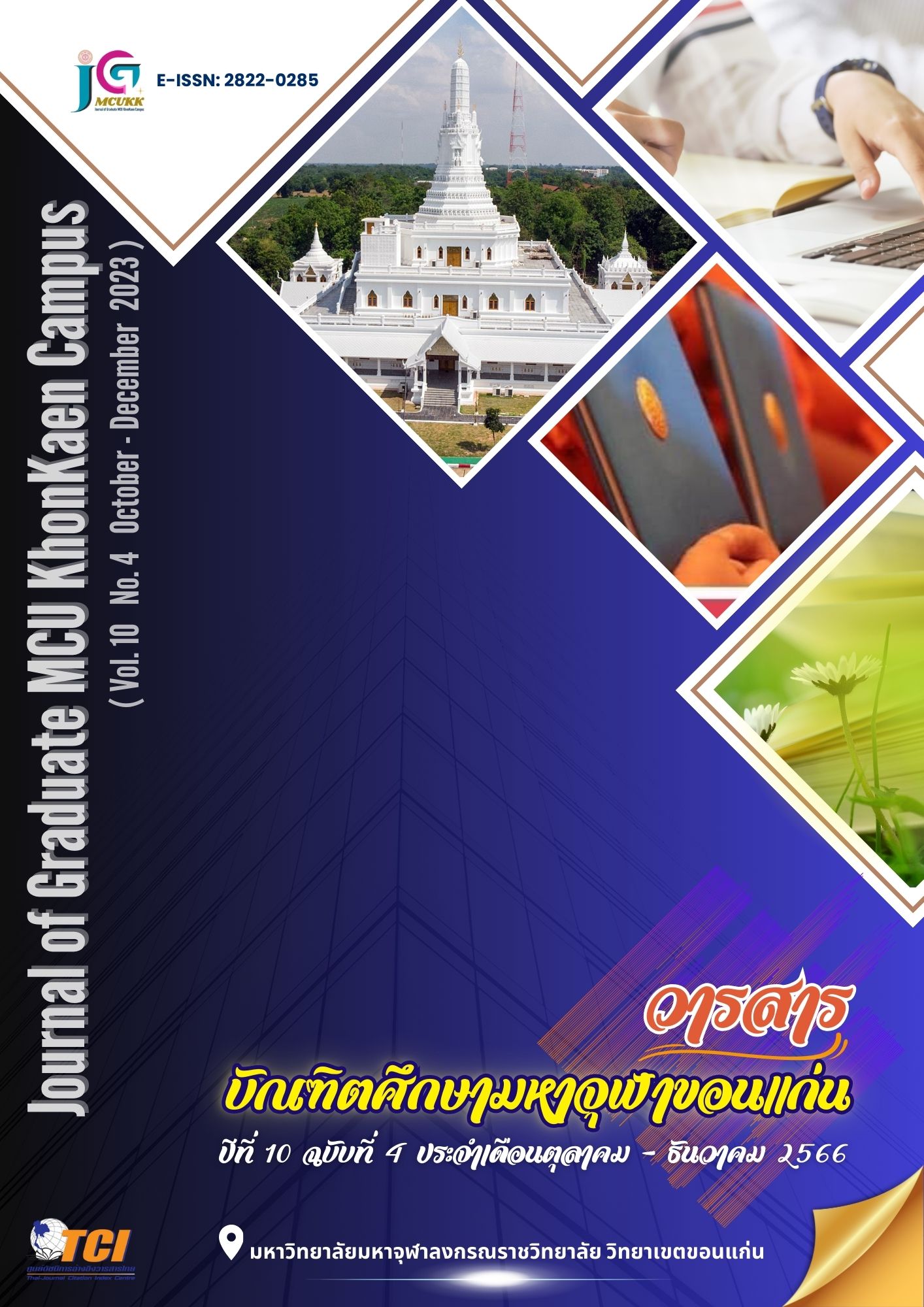The Development of a Knowledge Management Model According to the Mission Wat (Temple), Pracha (People), Rat (State) for the Happiness Creation project in the Administrative Area of the Sangha Region 10
Main Article Content
Abstract
The objectives of this research were 1) to study the state of knowledge management according, 2) to develop a model for knowledge management according, 3) to present a knowledge management model according, and 4) to evaluate the experimental use of the management model. Knowledge according to the mission, the Pracharat Temple Creates Happiness Project in the administrative region of the Sangha Region 10. The samples were monks and Buddhists. totaling 150 images/person. by specific selection method The research model is R&D, conducting research in 4 phases. The tools used were the mission-based knowledge management model; pattern manual mission-based knowledge management model assessment form and the satisfaction questionnaire on the use of the knowledge management model according to the mission of the Pracharat Temple Building Suk Project in the Sangha Administration Region 10. The statistics used in the data analysis were mean, standard deviation. and content analysis
The research were as follows
1. Mission-based knowledge management conditions Pracha Rat Sang Suk Temple Project in Ecclesiastical Administrative Region 10 Overall, there is a need for knowledge management of the project first. PNImodified value was 0.36, followed by risk management in the project. PNImodified value was 0.34 value, general condition management of the project PNI modified value was 0.33
2. The knowledge management model according to the mission, the Pracharath Temple Sang Suk project in the 10th Sangha administrative region found that there were 4 components as follows: KMSRU Model consisting of 1) K : KM (Knowledge Mission) (knowledge management according to mission ) 2) S : Sharing (exchanging learning through activities) 3) R : Reflect (reflecting knowledge management results) 4) U : Utilization (utilization)
3. Evaluation of the experiment of a mission-based knowledge management model Pracha Rat Building Happiness Temple Project in Buddhist Ecclesiastical
Administration Region 10 Development of physical space of temples and communities to be clean, shady, beautiful as a place of sappaya. Have the highest level of practice
4. The overall assessment of the manual was at the highest level, and the results of the assessment of satisfaction with the knowledge management model according to the mission. The Pracharath Sangsuk Temple Project in the Buddhist Clergy Region 10 as a whole is at the highest level.
Article Details

This work is licensed under a Creative Commons Attribution-NonCommercial-NoDerivatives 4.0 International License.
References
ทิศนา แขมมณี. (2550). ศาสตร์การสอน. (พิมพ์ครั้งที่ 5). กรุงเทพฯ: ด่านสุทธาการพิมพ์ จำกัด. ฝ่ายสาธารณูปการของมหาเถรสมาคม. (2564). โครงการ วัด ประชา รัฐ สร้างสุข "วัดสวยด้วยความสุข". สืบค้นเมื่อ 15 มกราคม 2565, จาก https://www.wat3579.com/.
พระมหาธฤติ รุ่งชัยวิทูร. (2557). รูปแบบการพัฒนาพระสังฆาธิการเพื่อประสิทธิภาพการบริหารกิจการคณะสงฆ์. (ดุษฎีนิพนธ์รัฐประศาสนศาสตร์). พระนครศรีอยุุธยา: มหาวิทยาลัยมหาจุฬาลงกรณราชวิทยาลัย.
พระเมธีธรรมาลังการ, (ประยุทธ ภูริธตฺโต). (2551). ประสิทธิภาพการบริหารกิจการคณะสงฆ์จังหวัดแพร่. (รายงานการวิจัย). แพร่: มหาวิทยาลัยมหาจุฬาลงกรณราชวิทยาลัย วิทยาเขตแพร่.
พระราชวรเมธี และคณะ. (2564). แผนยุทธศาสตร์การปฏิรูปกิจการพระพุทธศาสนา 2560 – 2564 “การนำนโยบายสู่การปฏิบัติ”. สืบค้นเมื่อ 15 มกราคม 2565, จาก http://www.buddhism4.com/web/download/book%201.
วาโร เพ็งสวัสดิ์. (2553). การวิจัยพัฒนารูปแบบ. วารสารมหาวิทยาลยราชภัฏสกลนคร, 2(4), 1-15.
เอนก นรสาร, สำราญ กำจัดภัย และ พจมาน ชำนาญกิจ. (2559). การพัฒนารูปแบบการจัดการความรู้โดยบูรณาการแนวคิดการรับรู้ความสามารถตนเองและการกำกับตนเอง เพื่อพัฒนาความสามารถด้านการจัดการเรียนการสอนของครูวิทยาลัยนาหว้า มหาวิทยาลัยนครพนม. (รายงานการวิจัย). นครพนม: มหาวิทยาลัยนครพนม.

